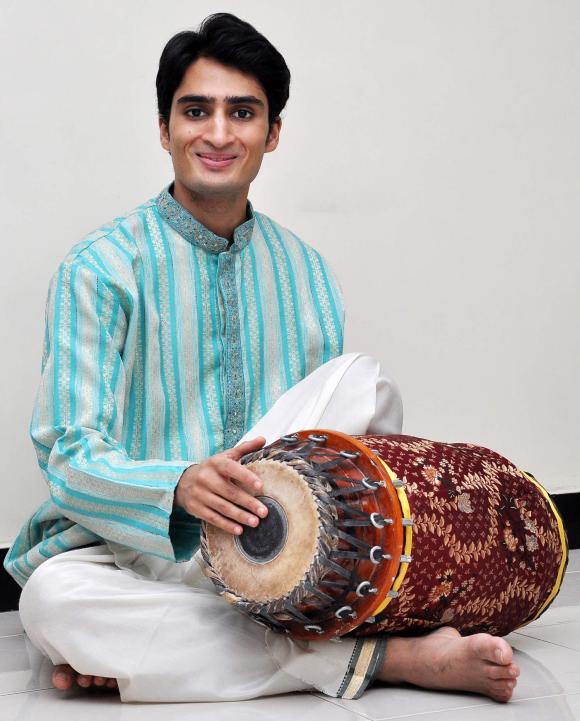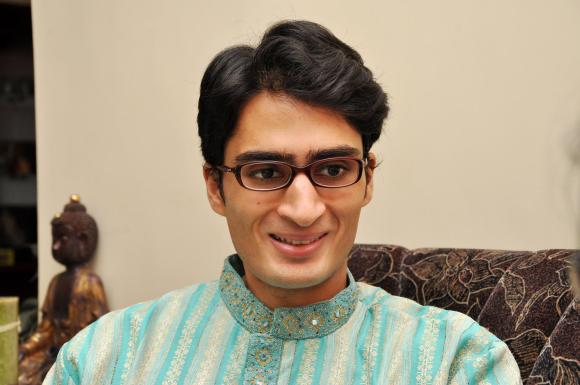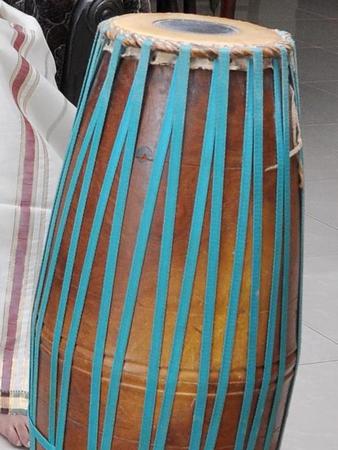 | « Back to article | Print this article |
The mridangam prodigy who set the stage on fire at 9
It was not expected of a young boy growing up in a small town in America to pick up an instrument like the Mridangam to play but then that was what Rohan Krishnamurthy did when he was an 8 year old.
It was also unexpected of the son of a University Professor and accountant to take up music as his profession. But then the 25 year old chose to do his PhD in Musicology at the Eastman School of Music in Rochester, NY.
Other than numerous awards, he also has a patent in the US for a new design for the Mridangam.
Rohan was in Chennai recently on a Fellowship as a part of his dissertation and also to participate in the yearly Margazhi music festival. He spoke to rediff.com on his journey as a musician.
Childhood in America
I grew up, did my school and college, and also learnt music in a small town called Kalamazoo in south west Michigan. I moved to New York four years ago to pursue my PhD.
My father is a professor in Geo and Environmental Science, and my mother is an accountant but my entire family is musical. All of us are very much interested in Carnatic music but no one had the opportunity to pursue it professionally. I was always interested in drums and percussion but somehow got fascinated by the Mridangam.
Luckily there was a Mridangam to learn on at home. My father had bought it from Kerala. He wanted to learn from Damodaran Srinivasan, a Mridangam teacher who was in town for a couple of years as a graduate student at the University. Somehow, his training fizzled out. So, there was this instrument and also the teacher, and one day, I asked my parents whether I could learn the Mridangam.
I was 8 years old then. Nobody thought I would take it up very seriously. I myself wonder why I took it up seriously. Perhaps the sound, the exposure to the instrument, the rhythmic aspect, and the instrument itself attracted me. It is an unusual instrument for a person who was growing up in America.
Learning Mridangam through telephone
But after a couple of months of learning, my teacher moved to Massachusetts for work, and there was no Mridangam teacher in a 300-mile radius. So, my teacher suggested I learn through speakerphone. Remember this was before Skype and virtual lessons started. Fortunately for me, before he left, he had given me a very strong foundation.
Soon, my e-classes started; he played over the phone and I translated it into scripts and practised. There were days when I practised 5 to 6 hours. I was that passionate. I continued learning through speakerphone for almost a couple of years and it actually worked out really well. It was quite a landmark in my musical journey.
On stage at age 9
In 1996, I happened to meet the legendary Mridangam player Sri Guruvayoor Dorai when he came on a concert tour to the US, and also visited Kalamazoo. My parents and I went to his concert and met him before the concert. Though we were meeting him for the first time, something clicked. He asked me, do you want to sit on the stage with me? I agreed, though I was not familiar with sitting on the stage. I remember I went up wearing my shoes! He then asked me to remove my shoes. The concert lasted five hours and all through the time, I was with him, doing thaalam. He was so impressed with my dedication that he offered to teach me when I came to Chennai next.
The next summer, in 1997, I was in Chennai to take lessons from him directly. I have been taking lessons from him for the last 15 years. Sometimes I come here to take lessons, or when he comes to the US, he often stays with us for a month or so, so that I could learn from him. I never had the luxury of having a teacher in the same city. But I used to practise hours and hours everyday. Also, my parents used to take me to all the concerts in the near vicinity.
The mridangam prodigy who set the stage on fire at 9
First performance at 9
Within a year after I started learning Mridangam, I started performing. I still remember my first serious performance at a day-long festival at Michigan. My mother was singing and I played for her. When the others saw a small kid performing, everyone asked me to perform with them, and I ended up playing 6-7 hours continuously. It was draining but I thoroughly enjoyed it.
After that, I had the opportunity to perform with some very senior artists like Prof T N Krishnan, Dr N Ramani, R K Srikantan, T N Seshagopalan, Chitravina N Ravikiran, S Shashank, T M Krishna, and S Sowmya from the age of 11 both in the US and in India. It was a wonderful learning experience.
Music as profession
From kindergarten to 12th grade, I was pursuing music parallel to academics. In college, I did a double major in music and chemistry. I learnt history, theory and performance in college. After my graduation, I wanted to do an advanced degree and it was at that time that I had to choose either music or science, or both forever. I decided to pursue music professionally. It was a major decision for me but I have very supportive parents, family, friends and teachers.
Doing PhD in Musicology at the Eastman School of Music in Rochester
Four years ago, I enrolled myself for a PhD in Musicology at the Eastman School of Music, regarded as the number one school to pursue music.
My PhD dissertation is about virtual musical classroom, which is online training in Carnatic percussion. I have been here in Chennai on a fellowship to do research on this.
The mridangam prodigy who set the stage on fire at 9
Virtual musical classroom
The joke that goes around is that when a student contacts a music teacher, he says, you have more chances of being my student if you move to the United States and take Skype classes!
Now I realise it is not a joke but a reality. People often ask me how virtual lessons can be compared to physical presence? They want to know whether they are as good. I would say the two systems are so different that it is like comparing apples and oranges. Real life and virtual experiences are two different things. True, face-to-face experience is holistic but virtual classroom is going to be a reality soon.
Many teachers here in Chennai have told me that they prefer virtual classrooms as they are economic. One of the teachers told me that taking classes online is earning in dollars and spending in rupees! It was a very honest answer. That is why most Chennai teachers are doing it.
On the other side, it is an opportunity for the students in the US to learn from teachers in India. It is mostly the immigrant parents who want to stay connected to their culture, that make their children learn Carnatic music.
Learning Mridangam in the United States
Many people have asked me why I have not moved to Chennai, the hub of Carnatic music but I feel living in the United States has been a major advantage for a musician like me. Having raised in the United States, I was exposed to so much diversity in music and I had the great opportunity to learn all kinds of world music and instruments. This has given me a global understanding of music and has helped me broaden my horizon as a musician.
Learning western classical music and percussion instruments has helped me immensely in playing Mridangam. I feel the more knowledge you have of music, the better. Knowing only one musical tradition is like knowing only one language.
The mridangam prodigy who set the stage on fire at 9
Cross cultural projects and not fusion
Carnatic music is not the only music in the world; there is music everywhere. Music is so vast and diverse and it is necessary to know world music to have a better understanding of what you perform. We live in an increasingly globalised world, and a lot of the musical projects I am doing are cross-cultural. Many people use the word fusion, which I am not very fond of.
I have been part of numerous cross-cultural projects with well-known symphony orchestras, jazz ensembles, and distinguished musicians including Grammy Award-winners Glen Velez and Vishwa Mohan Bhatt, Anoushka Shankar, and Ayano Ninomiya.
Patent for Mridangam
I have been working on a new design for the Mridangam for a couple of years. Now I have been awarded a United States patent for this design. It is a general drum patent and not specifically for Mridangam though my research began on the Mridangam. My design combines the traditional fastening system and aesthetics with a modern, nut-and-bolt system of tightening to make the drum more user-friendly and sturdy for practitioners worldwide.
The drum heads are the same, the only thing that is different is the strapping. The instrument is traditionally very artisan dependant. But the advantage of what I have designed is, he need not take it to the expert to tune the drum. If the artist wants to make any change in the pitch, etc. he himself can do it with a wrench as it is a nut and bolt system. Also, the artist himself can change the drumhead in minutes.
It can also go to the entire pitch range in Carnatic music. A lot of people have asked me whether it sounds the same but my tests have shown no difference. The Indian percussion industry is rapidly growing in the United States and I am confident my invention will be beneficial to musicians of various backgrounds.
There are two-dozen orders already and by next year, this will be available for commercial sale.
Musical mission
After my PhD, I would be performing, teaching and composing independently. I also want to create a new University programme that combines Carnatic music performance especially percussion and scholarship. I plan to start this programme in an American University not for Indian students alone but for students coming from all cultural backgrounds. It will be a first-of-its-kind venture.
My musical mission is to propagate and promote Carnatic percussion and Carnatic music at the international level and also foster cross cultural understanding through musical projects.



